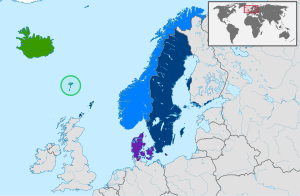| North Germanic | |
|---|---|
| Nordic Scandinavian | |
| Geographic distribution | Northern Europe |
| Ethnicity | North Germanic peoples |
| Linguistic classification | Indo-European
|
| Proto-language | Proto-Norse |
| Subdivisions | |
| Language codes | |
| ISO 639-5 | gmq |
| Glottolog | nort3160 |
 North Germanic-speaking lands
Continental Scandinavian languages: Insular Nordic languages: Norn (†)
| |
The North Germanic languages make up one of the three branches of the Germanic languages—a sub-family of the Indo-European languages—along with the West Germanic languages and the extinct East Germanic languages. The language group is also referred to as the Nordic languages, a direct translation of the most common term used among Danish, Faroese, Icelandic, Norwegian, and Swedish scholars and people.
The term North Germanic languages is used in comparative linguistics,[1] whereas the term Scandinavian languages appears in studies of the modern standard languages and the dialect continuum of Scandinavia.[2][3] Danish, Norwegian and Swedish are close enough to form a strong mutual intelligibility where cross-border communication in native languages is very common, particularly between the latter two.
Approximately 20 million people in the Nordic countries speak a Scandinavian language as their native language,[4] including an approximately 5% minority in Finland. Besides being the only North Germanic language with official status in two separate sovereign states, Swedish is also the most spoken of the languages overall. 15% of the population in Greenland speak Danish as a first language.[5]
This language branch is separated from the West Germanic languages, consisting of languages like English, Dutch, and German to the south, and does not include Finnish to the east, which belongs to the completely unrelated Uralic language family.
- ^ Gordon, Raymond G., Jr. (ed.), 2005. Language Family Trees Indo-European, Germanic, North Archived 3 October 2012 at the Wayback Machine. Ethnologue: Languages of the World, Fifteenth edition. Dallas, Texas: SIL International
- ^ Scandinavian Dialect Syntax Archived 12 January 2012 at the Wayback Machine. Network for Scandinavian Dialect Syntax. Retrieved 11 November 2007.
- ^ Cite error: The named reference
Torpwas invoked but never defined (see the help page). - ^ Holmberg, Anders and Christer Platzack (2005). "The Scandinavian languages". In The Comparative Syntax Handbook, eds Guglielmo Cinque and Richard S. Kayne. Oxford and New York: Oxford University Press. Excerpt at Durham University Archived 3 December 2007 at the Wayback Machine.
- ^ "Sprog og politik i Grønland". Forenede Nationers (in Danish). 21 February 2021. Archived from the original on 21 February 2022. Retrieved 21 February 2022.